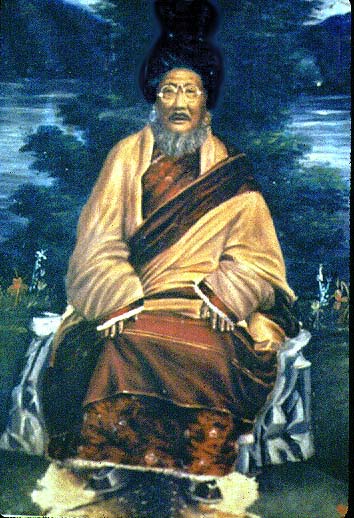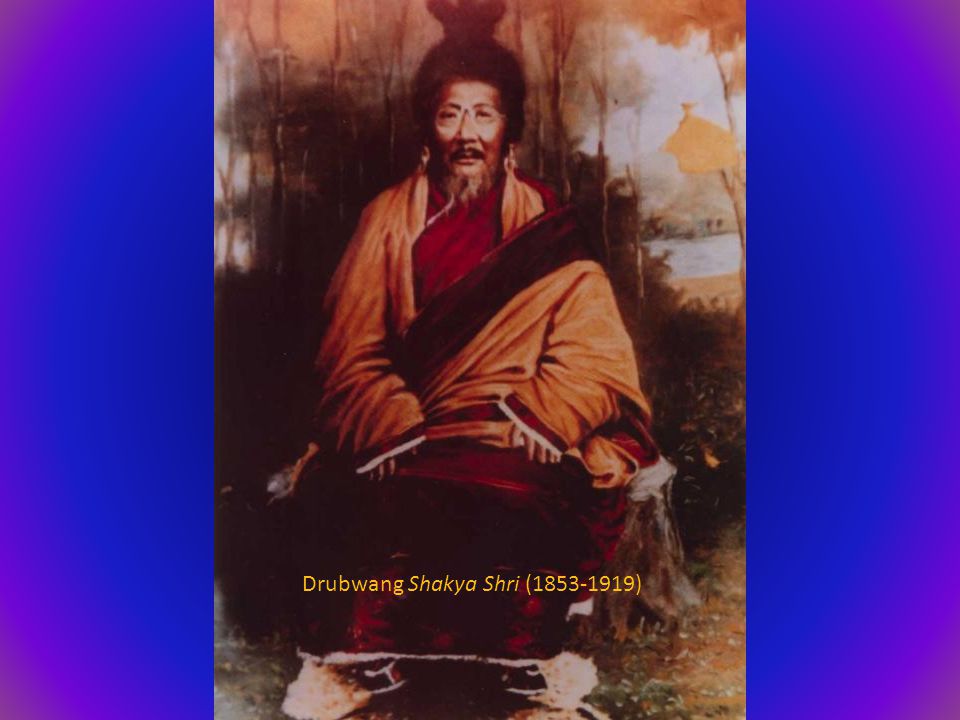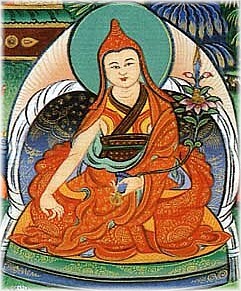Togden Drubwang Shakya Shri Jnana

Togden Drubwang Shakya Shri – (b.1853 – d.1919, ཤཱཀྱ་ཤྲཱི། Śākya Śrī, shAkya shrI) was born in 1853, the female water-ox year in Kham to a nomadic family. His father was named Naru Donden (sna ru don den, d.u.) and his mother was Nyamtso Dron (nyam tsho sdron, d.u.). He had an uncle named Pentsa (pen tsa, d.u.).
As a child, Śākya Śrī was said to be soft-spoken and inclined towards dharma practice. He would often use soil and pebbles as objects of offerings, sometimes sitting on raised stone platforms in a Mahāmudrā pose, imitating meditation. Other times he would act as if conferring teachings on his playmates. According to legend, when Śākya Śrī was about four years old, a beautiful female yogi appeared to his parents and told them that the child had descended from the ḍākinī.

It is said that he was easily moved by the suffering of others and was often found in tears after seeing others in misery. As a result of his compassion, he frequently dedicated the positive results of his practice towards their benefit.
Dharma
As a young man Śākya Śrī worked as a cook at Drugu (gru gu), a Drukpa Kagyu monastery in the Chamdo region. When his kitchen duties were completed, he would sit beside the hearth and do his practice, tying his hair to the ceiling so that he would not fall asleep. Once during a high teaching, Śākya Śrī was serving tea to the First Tsoknyi, Pema Drime Ozer (tshogs gnyis, padma dri med ‘od zer, b. 1828), who was considered a reincarnation of both Rechung Dorje Drakpa (ras chung rdo rje grags pa, 1085-1161) and Ratna Lingpa (rat na gling pa, 1403-1479).
Śākya Śrī attempted to listen to the teachings, and caught the attention of some of the monks in the audience, who laughed at him, saying,
“The long nosed nephew of Pentsa should go back to his kitchen.”
Śākya Śrī (or, in other versions of the story, Tsoknyi) retorted that they should not mock him, as in the future they would be longing even for a drop of his urine.
After being ordained as a monk at Drugu, Śākya Śrī took lessons in Mahāmudrā from the Sixth Khamtrul, Tenpai Nyima (khams sprul 06 bstan pa’i nyi ma, 1819-1907), who became his root teacher. He also received initiations in Dzogchen teachings from Jamyang Khyentse Wangpo (‘jam dbyangs mkhyen brtse dbang po, 1820-1892).

He later abandoned his vows and, for many years he practiced in the remote mountain caves of the Kham region with his consort Chozang Dolma (chos bzang sgrol ma, d.u.) and their children. He had four daughters and six sons; one of the sons was named Ngawang Choying (ngag dbang chos dbyings, d.u.), and another, Pakchok Dorje (‘phags mchog rdo rje, 1893-1943) was identified as the mind emanation of Jamyang Khyentse Wangpo. Mocking monks referred to him as “the dirty yogi with large family.”
His reputation was made when the Sixth Dechen Chokhor Yongdzin, Sheja Kunkhyen (bde chen chos ‘khor yongs ‘dzin 06 shes bya kun mkhyen, d.u.) camped below the cave of Śākya Śrī to give teachings. Yongdzin had a vision in which he saw the maṇḍala of thirteen-deity Cakrasaṃvara pointing towards the cave of Śākya Śrī. Asking who was in the cave, he was informed of the presence of a “dirty yogi.” He invited Śākya Śrī to test his yogic power, and was amazed at his achievements, and have him the title Drubwang (sgrub dbang).
Ju Mipham Gyatso
During his first encounter with Ju Mipham Gyatso (‘ju mi pham rgya mtsho, 1846-1912) at Gatra Guri (dga’ tra gu ri), Śākya Śrī was attending a prayer ceremony with about five hundred monks.

According to his hagiography, at dawn, he saw a vision of Mañjuśrī, orange in color and having four arms, holding a sword in one hand, and a bow, an arrow, and a book in the other. He held this vision for a while and later understood that this vision of Mañjuśrī was none other than Mipam Gyatso. He received further teachings from him, specifically the Pel Kuntu Zangpoi Monlam (dpal kun tu bzang po’i smon lam), and the two sat together in conversation for fifteen days. Mipam Gyatso commented that Śākya Śrī was also Jampeyang in human body and called him Śākya Śrī jñāna, which indicated his profound understanding of Dzogchen views.
Students

Śākya Śrī’s fame was considerable, and students gathered from throughout the Himalayan region, including Bhutan. These included
- Sonam Zangpo (bsod nams bzang po, 1892-1983), the son of Trongsa Ponlob Jigme Namgyel (krong gsar dpon slob ‘jigs med rnam rgyal, d.u.), and the brother of the first King of Bhutan;
- Lama Monlam Rabzang (smon lam rabbzang, 1879-1945.);
- Kunlha Tendzin (kun lha bstan ‘dzin, d.u.);
- Sonam Gyeltsen (bsod nams rgyal mtshan, d.u.);
- Ngawang Tendzin Gyatso (ngag dbang bstan ‘dzin rgya mtsho, 1883-1966), and
- the Tenth Drukchen, Mipam Chokyi Wangpo (‘brug chen 10 mi pham chos kyi dbang po, 1884-1930).
He stayed in places like Padmako and Khenpajong in Bhutan, and also Sikkim and Nepal. In Nepal, he sponsored a renovation of the Swayambhunath and Boudanath stupas and of Namo Buddha. These projects were later completed by his sons.
At the end of his life, although continuing to teach, Śākya Śrī told his students that the time had come for him to pass into nirvana, and he showed signs of illness soon thereafter. When his children and students offered him medicine and prayers of propitiations for him to live longer, Śākya Śrī said that while medicine and prayers would ultimately make no difference, they could continue, as it would bring them merit.
Śākya Śrī passed away in 1919, the female-sheep year. He is said to have displayed the rainbow body (‘ja’ klu), transforming his body into light.
His disciple Sonam Zangpo edited a few volumes of his teachings.
Shakya Shri name variants
Name variants:
- Drubpai Wangchuk Chenpo Sarahai Tulpa Shakya Shrijnyana;
- Drugu Tokden Shakya Shri;
- Jalu Dorje Tsel;
- Kunzang Gangshar Rangdrol;
- Tokden Shakya Shri;
- Tsokdruk Rangdrol Jalu Dorje Tsel.
Teachers of Shakya Shri
Mipam Gyatso b.1846 – d.1912
Name variants: Jamgon Mipam Gyatso; Ju Mipam Gyatso; Mipam Namgyel Gyatso.
Jamyang Khyentse Wangpo b.1820 – d.1892
Name variants: Dorje Zijitsal; Jigme Khyentse Nyugu; Khyentse Wangpo; Kunga Tenpai Gyeltsen Pelzangpo; Osel Dorje Tukchoktsal; Osel Tulpai Dorje; Pema Osel Do-ngag Linpa; Tsangse Gyepai Loden; Tsokye Lama Gyepaibang; Tsuglamawai Nyima Tsokye Shonnui Langtso.
Jamgon Kongtrul Lodro Taye b.1813 – d.1899
Name variants: Chime Tennyi Yudrung Lingpa; Jamgon Kongtrul Yonten Gyatso; Karma Ngawang Yonten Gyatso; Karma Ngawang Yonten Gyatso Trinle Kunkhyab Pel Zangpo; Kongtrul Ngawang Lodro Taye; Kongtrul Ngawang Yonten Gyatso; Pema Gargyi Wangchuk Tsel; Pema Garwang Lodro Taye; Pema Garwang Trinle Drodul Tsel; Tendzin Yungdrung Lingpa; Tennyi Yungdrung Lingpa; Zilnon Gepa Tsel.
bstan pa’i nyi ma b.1849 – d.1907
pad-ma dri med ‘od zer b.1828
Shakya Shri’s students
kun lha bstan ‘dzin
bsod nams rgyal mtshan
bsod nams bzang po b.1892 – d.1983
Lama Monlam Rabzang b.1878 – d.1945

Name variants: Mipam Sheja Dorje; Monlam Rabzang.
Ngawang Tendzin Gyatso b.1883 – d.1966
Name variants: Sanggye Norbu.
The Fourth Petseling, Kunzang Trinle Namgyel b.1892 – d.1957
Name variants: Kunchab Gyurme; Kunzang Ngedon Tendzin Chogyel; Petsaling Tulku 04.
Shakya Shri’s bibliography
Chos kyi rgya mtsho. 1980. Rje btsun bla ma rdo rje ‘chang chen po shAkya shrI dz+nyA na’i rnam thar me tog phreng ba. Gangtok: Sherab Gyeltsen.
Ngag dbang chos grags. 1974. Dpal rgyal dbang ‘brug pa’i gdan rabs mdor bsdus ngo mtshar gser gyi lde mig. Darjeeling: Kargyud Sungrab Nyamso Khang, pp. 46-47.
Nyoshul Khenpo. 2005. A Marvelous Garland of Rare Gems. Richard Barron, trans. Junction City, California: Padma Publication, pp. 442-443.
Tulku Urgyen Rinpoche. 2005. Blazing Splendor: The Memoirs of Tulku Urgyen Rinpoche. Hong Kong: Rangjung Yeshe, pp. 129-134.


